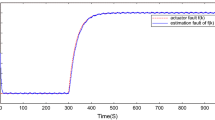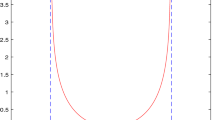Abstract
This article investigates the problem of fault diagnosis (FD) for a class of nonlinear state-feedback control systems subject to parameter uncertainties. The considered nonlinear systems are described by T–S fuzzy models with local nonlinear parts and uncertain grades of membership. First, a general actuator fault model is proposed, which considers bias faults and gain faults. Then, a switching technique is introduced to address the unknown membership functions, external disturbances, faults, and their coupling. Furthermore, an adaptive FD observer design method combined with the switching technique is proposed to estimate the occurred actuator fault. It is noted that the obtained fault errors converge exponentially to zero. Finally, a numerical example of NSV reentry dynamic model is given to confirm the effectiveness of the new results.




Similar content being viewed by others
References
Wang, H., Daley, S.: Actuator fault diagnosis: an adaptive observer-based technique. IEEE Trans. Autom. Control 41(7), 1073–1078 (1996)
Tan, C.P., Edwards, C.: Sliding mode observers for detection and reconstruction of sensor faults. Automatica 38(10), 1815–1821 (2002)
Gao, Z., Wang, H.: Descriptor observer approaches for multivariable systems with measurement noises and application in fault detection and diagnosis. Syst. Control Lett. 55(4), 304–313 (2006)
Wang, D., Lum, K.Y.: Adaptive unknown input observer approach for aircraft actuator fault detection and isolation. Int. J. Adapt. Control Signal Process. 21(1), 31–48 (2007)
Armeni, S., Casavola, A., Mosca, E.: A robust fault detection and isolation filter design under sensitivity constraint: an LMI approach. Int. J. Robust Nonlinear Control 34(4), 1493–1506 (2008)
Yang, G.H., Wang, H.: Fault detection for a class of uncertain state-feedback control systems. IEEE Trans. Control Syst. Technol. 18(1), 201–212 (2010)
Seliger, R., Frank, P.: Fault diagnosis by disturbance decoupled nonlinear observers. Proceedings of the 30th IEEE Conference on Decision and Control, Brighton, England, 2248–2253 (1991).
Xu, A., Zhang, Q.: Nonlinear system fault diagnosis based on adaptive estimation. Automatica 40, 1181–1193 (2004)
Zhao, X.G., Li, J., Ye, D.: Fault detection for switched systems with finite-frequency specifications. Nonlinear Dyn. 70(1), 409–420 (2012)
Takagi, T., Sugeno, M.: Fuzzy indentification of systems and its applications to modeling and control. IEEE Trans. Syst. Man Cybern. 15(1), 116–132 (1985)
Tanaka, T., Wang, H.O.: Fuzzy Control Systems Design and Analysis: A Linear Matrix Inequlity Approach. Wiley, New York (2001)
Patton, R.J., Chen, J., Lopez-Toribio, C.J.: Fuzzy observer for nonliear dynamic systems. IEEE Conference on Decision and Control, CDC98, Tampa Florida, 84–89 (1998).
Akhenak, A., Chadli M., Ragot, J., Maquin, D.: Sliding mode multiple observer for fault detection and isolation. 42th IEEE Conference on Decision and Control, Hawaii, 9–12 Dec (2003).
Nguang, S.K., Shi, P., Ding, S.: Fault detection for uncertain fuzzy systems: an LMI approach. IEEE Trans. Fuzzy Syst. 15, 1251–1262 (2007)
Gao, Z., Shi, X., Ding, S.X.: Fuzzy state-disturbance observer design for T–S fuzzy systems with application to sensor fault estimation. IEEE Trans. SMC 38(3), 875–880 (2008)
Yang, H., **a, Y., Liu, B.: Fault detection for T-S fuzzy discrete systems in finite-frequency domain. IEEE Trans. Syst. Man Cybern. 41(4), 911–920 (2011)
Jee, S.C., Lee, H.J., Joo, Y.H.: Sensor fault detection observer design for nonlinear systems in Takagi–Sugeno’s form. Nonlinear Dyn. 67(4), 2343–2352 (2012)
Dong, H., Wang, Z., Lam, J., Gao, H.: Fuzzy-model-based robust fault detection with stochastic mixed time delays and successive packet dropouts. IEEE Trans. Syst. Man Cybern. 42(2), 365–376 (2012)
Boskovic, J.D., Mehra, R.K.: Stable multiple model adaptive flight control for accommodation of a large class of control effector failures. Proceedings of ACC, 1920–1924(1999).
Jiang, B., Staroswiecki, M., Cocquempot, V.: Fault estimation in nonlinear uncertain systems using robust/sliding-mode observers. IEE Proc. Control Theor. Appl. 151, 29–37 (2004)
Jiang, B., Chowdhury, F.N.: Parameter fault detection and estimation of a class of nonlinear systems using observers. J. Frankl. Inst. 342, 725–736 (2005)
Nguang, S.K., Shi, P., Ding, S.: Delay-dependent fault estimation for uncertain time-delay nonlinear systems: an LMI approach. Int. J. Robust Nonlinear Control 16, 913–933 (2006)
Gao, Z., Ding, S.X.: State and disturbance estimator for time-delay systems with application to fault estimation and signal compensation. IEEE Trans. Signal process. 55(12), 5541–5551 (2007)
Zhang, K., Jiang, B., Shi, P.: Fault estimation observer design for discrete-time takagi-sugeno fuzzy systems based on piecewise Lyapunov functions. IEEE Trans. Fuzzy Syst. 20(1), 192–200 (2012)
Shen, Q., Jiang, B., Cocquempot, V.: Fault-tolerant control for T–S fuzzy systems with application to near-space hypersonic vehicle with actuator faults. IEEE Trans. Fuzzy Syst. 20(4), 652–665 (2012)
Liu, M., Cao, X., Shi, P.: Fault estimation and tolerant control for fuzzy stochastic systems. IEEE Trans. Fuzzy Syst. 21(1), 221–229 (2013)
Wu, L.G., Ho, D.W.C.: Fuzzy filter design for It\(\widehat{o}\) stochastic systems with application to sensor fault detection. IEEE Trans. Fuzzy Syst. 17(1), 233–242 (2009)
Li, X., Yang, G.H.: Fault detection for T–S fuzzy systems with unknown membership functions. IEEE Trans. Fuzzy Syst. (2013). doi:10.1109/TFUZZ.2013.2249519.
Dong, J., Yang, G.H.: Control synthesis of continuous-time T–S fuzzy systems with local nonlinear models. IEEE Trans. Syst. Man Cybern. 39(5), 1245–1258 (2009)
Narendra, K.S., Balakrishnan, J.: Adaptive control using multiple models. IEEE Trans. Autom. Control 42(2), 171–187 (1997)
Shen, Q., Jiang, B., Cocquempot, V.: Fuzzy logic system-based adaptive fault-tolerant control for near-space vehicle attitude dynamics with actuator faults. IEEE Trans. Fuzzy Syst. 21(2), 289–300 (2013)
Wang, Y., Wu, Q.X., Jiang, C.H., Huang, G.Y.: Reentry attitude tracking control based on fuzzy feedforward for reusable launch vehicle. Int. J. Control, Autom. Syst. 7(4), 503–511 (2009)
Acknowledgments
This study was supported by the Funds of National Science of China (Grant Nos. 61273155, 61322312, and 61273148), the Fundamental Research Funds for the Central Universities (Grant Nos. N110804001, N120504003, N120604005, and N120604006), the Foundation for the Author of National Excellent Doctoral Dissertation of P.R. China (Grant No. 201157), the Foundation of State Key Laboratory of Robotics (Grant No. 2012-001), the IAPI Fundamental Research Funds (Grant Nos. 2013ZCX01-01, 2013ZCX01-02), and the New Century Excellent Talents in University (Grant No. NCET-11-0083).
Author information
Authors and Affiliations
Corresponding author
Appendix
Appendix
In this section, a simple state-feedback controller design method is proposed in the form of linear matrix inequalities, and the controller is described as
Define the performance output
where \(C_{zi}, D_{i1}, D_{i2}, N_{i2} (i=1,\ldots , N)\) are known matrices.
The considered \(H_{\infty }\) state-feedback controller (50) is designed such that,
-
(1)
For a prescribed \(H_{\infty }\) performance bound \(\gamma >0\), the closed-loop system (11) in fault-free case is stable with
$$\begin{aligned} \int \limits _{0}^{\infty }z^{T}(t)z(t)dt\le \gamma ^{2}\int \limits _{0}^{\infty }\overline{w}^{T}(t)\overline{w}(t)dt \end{aligned}$$(51) -
(2)
For a prescribed \(H_{\infty }\) performance bound \(\gamma _{1}>0\), the closed-loop system (11) in faulty case is stable with
with \(\overline{w}(t)=[ w^{T}(t) y_{r}^{T}(t)]^{T} \).
Lemma 1
For the prescribed \(\gamma >0\), \(\gamma _{1}>0\), the closed-loop augmented system (11) is stable, and the performances (51) and (52) are satisfied if there exist matrices \(Q=Q^{T}>0, L_{a}, L_{b}\), and \(\lambda \) such that
for \(i=1,\ldots , N, j=1,\ldots , m\) with \(\overline{E}=[0 E ] , \varrho _{j}=diag\{0,\ldots \rho _{j},\ldots 0\}, \rho _{j}\in \{\underline{\rho }_{j},\ \overline{\rho }_{j}\}\), and the controller gains are given as \( K_{a}=L_{a}Q^{-1},\ K_{b}=L_{b}\lambda ^{-1}.\)
Proof
The proof is easily obtained from the techniques in [29] and omitted.
Rights and permissions
About this article
Cite this article
Wang, H., Ye, D. & Yang, GH. Actuator fault diagnosis for uncertain T–S fuzzy systems with local nonlinear models. Nonlinear Dyn 76, 1977–1988 (2014). https://doi.org/10.1007/s11071-014-1262-z
Received:
Accepted:
Published:
Issue Date:
DOI: https://doi.org/10.1007/s11071-014-1262-z




